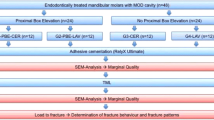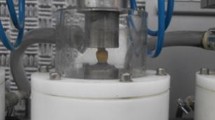Abstract
Polyacid-modified resin composite (PMC) restorations are being increasingly used in class II cavities in primary teeth. The aim of this study was to evaluate the interfacial adaptation of 1-month- and 30-month-old in vivo restorations by quantitative scanning electron microscopy (SEM) evaluation. Twelve PMC restorations were performed under clinically controlled conditions in primary molars planned for extraction 1 month later for orthodontic reasons. Eleven other PMC restorations, aged 30 months (range 1.5–3 years) and part of a multicenter study, were collected after exfoliation. To observe the interfacial adaptation of each restoration at several levels a thin layer of the proximal surface was ground off 2–3 times. Replica impressions of each level were prepared for SEM. The interfaces of the replicas were evaluated at ×200 and ×1000. In the 1-month-old restorations gap-free adaptation to enamel was found in 87% and to dentin in 84% of the total interfacial length investigated. For the 30-month-old restorations gap-free adaptation was registered in 59 and 63%, respectively. The interfacial quality was significantly better in the 1-month-old restorations than in those 30 months of age. Adaptation to enamel was significantly better in the cervical part of the 1-month-old restorations than in the axial walls, whereas there was no significant difference in dentin. No significant difference was found between the cervical and axial cavity walls of the 30-month-old restorations. Enamel fractures were registered in 31 and 24%, respectively of the interfacial length of the 1-month- and 30-month-old restorations. The corresponding findings in dentin were 0 and 0.9%. It can be concluded that restorations aged for a short time showed a high percentage of sealing, which decreased significantly for the 30-month-old ones.
Similar content being viewed by others

Author information
Authors and Affiliations
Additional information
Received: 24 June 1998 / Accepted: 7 October 1998
Rights and permissions
About this article
Cite this article
Andersson-Wenckert, I., van Dijken, J. & Hörstedt, P. Interfacial adaptation of in vivo aged polyacid-modified resin composite (compomer) restorations in primary molars . Clinical Oral Investigations 2, 184–190 (1998). https://doi.org/10.1007/s007840050068
Issue Date:
DOI: https://doi.org/10.1007/s007840050068



